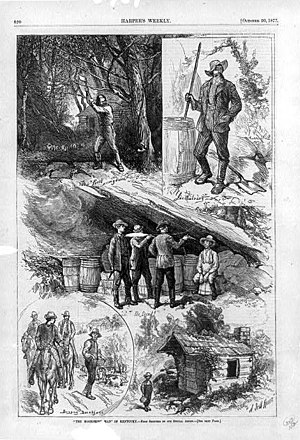
Methanol is an organic chemical compound and the simplest aliphatic alcohol, with the chemical formula CH3OH. It is a light, volatile, colorless and flammable liquid with a distinctive alcoholic odour similar to that of ethanol . Methanol acquired the name wood alcohol because it was once produced chiefly by the destructive distillation of wood. Today, methanol is mainly produced industrially by hydrogenation of carbon monoxide.

Moonshine is high-proof liquor, generally whiskey, traditionally made or distributed illegally. Its clandestine distribution is known as bootlegging. The name was derived from a tradition of creating the alcohol during the nighttime, thereby avoiding detection. In the first decades of the 21st century, commercial distilleries have adopted the term for its outlaw cachet and begun producing their own legally sanctioned, novelty "moonshine", including many flavored varieties, that in some sense continue its tradition, generally having a similar method and/or location of production.
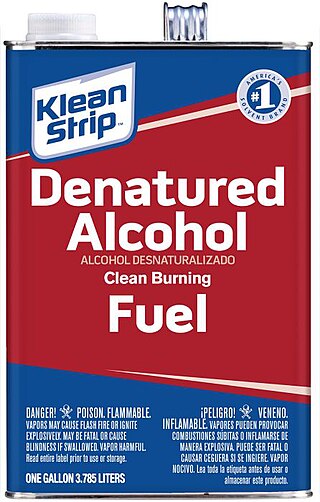
Denatured alcohol, also known as methylated spirits, metho, or meths in Australia, Ireland, New Zealand, South Africa, and the United Kingdom; and denatured rectified spirit is ethanol that has additives to make it poisonous, bad-tasting, foul-smelling, or nauseating to discourage its recreational consumption. It is sometimes dyed so that it can be identified visually. Pyridine and methanol, each and together, make denatured alcohol poisonous; and denatonium makes it bitter.
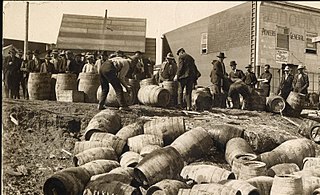
Rum-running, or bootlegging, is the illegal business of smuggling alcoholic beverages where such transportation is forbidden by law. Smuggling usually takes place to circumvent taxation or prohibition laws within a particular jurisdiction. The term rum-running is more commonly applied to smuggling over water; bootlegging is applied to smuggling over land.
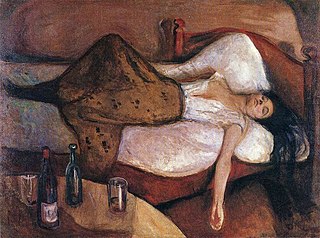
A hangover is the experience of various unpleasant physiological and psychological effects usually following the consumption of alcohol, such as wine, beer, and liquor. Hangovers can last for several hours or for more than 24 hours. Typical symptoms of a hangover may include headache, drowsiness, concentration problems, dry mouth, dizziness, fatigue, gastrointestinal distress, absence of hunger, light sensitivity, depression, sweating, hyper-excitability, irritability, and anxiety.
Surrogate alcohol is a term for any substance containing ethanol that is intentionally consumed by humans but is not meant for human consumption. Some definitions of the term also extend to illegally produced alcoholic beverages.

Akpeteshie is a liquor produced by distilling palm wine or sugar cane, primarily in the region of Western Africa. It is the national spirit of Ghana. In Nigeria it is known as Ògógóró (Ogog'), a Yoruba word, usually distilled locally from fermented Raffia palm tree juice, where it is known as the country's homebrew. Today, there is a misconception that Ogogoro can be pure ethanol, but traditionally, it had to come from the palm tree and then be distilled from this source.

The Prohibition era was the period from 1920 to 1933 when the United States prohibited the production, importation, transportation and sale of alcoholic beverages. The alcohol industry was curtailed by a succession of state legislatures, and finally ended nationwide under the Eighteenth Amendment to the United States Constitution, ratified on January 16, 1919. Prohibition ended with the ratification of the Twenty-first Amendment, which repealed the Eighteenth Amendment on December 5, 1933.
The Gujarat alcohol poisonings occurred in July 2009 in Gujarat, resulting in the death of 136 people from consumption of bootleg liquor.

Alcohol laws are laws relating to manufacture, use, being under the influence of and sale of alcohol or alcoholic beverages. Common alcoholic beverages include beer, wine, (hard) cider, and distilled spirits. Definition of alcoholic beverage varies internationally, e.g., the United States defines an alcoholic beverage as "any beverage in liquid form which contains not less than one-half of one percent of alcohol by volume". Alcohol laws can restrict those who can produce alcohol, those who can buy it, when one can buy it, labelling and advertising, the types of alcoholic beverage that can be sold, where one can consume it, what activities are prohibited while intoxicated, and where one can buy it. In some cases, laws have even prohibited the use and sale of alcohol entirely.
This is an alphabetic list of moonshine produced in various countries. The term bathtub gin refers to any style of homemade spirit made in amateur conditions of historical reason. Some distilled drinks on the list below are flavored, and some also national liquors.
The Tamil Nadu State Marketing Corporation (TASMAC) is a company owned by the Government of Tamil Nadu, which has a monopoly over wholesale and retail vending of alcoholic beverages in the Indian state of Tamil Nadu. It controls the Indian Made Foreign Liquor (IMFL) trade in the state.

Alcohol-related crime refers to criminal activities that involve alcohol use as well as violations of regulations covering the sale or use of alcohol; in other words, activities violating the alcohol laws. Underage drinking and drunk driving are the most prevalent alcohol‐specific offenses in the United States and a major problem in many, if not most, countries worldwide. Similarly, arrests for alcohol-related crimes constitute a high proportion of all arrests made by police in the U.S. and elsewhere.

Alcohol, sometimes referred to by the chemical name ethanol, is a depressant drug that is the active ingredient in fermented drinks such as beer, wine, and distilled spirits. It is one of the oldest and most commonly consumed recreational drugs, causing the characteristic effects of alcohol intoxication ("drunkenness"). Among other effects, alcohol produces happiness and euphoria, decreased anxiety, increased sociability, sedation, impairment of cognitive, memory, motor, and sensory function, and generalized depression of central nervous system (CNS) function.
Cholai is an illegal alcoholic beverage made in India, equivalent to "hooch" or "bootleg" alcohol. Usually made from rice, it is sometimes mixed with industrial alcohol or methanol, which has resulted in several hundred deaths.
Alcohol prohibition in Tamil Nadu is governed by State Prohibition and Excise department as per Tamil Nadu Prohibition Act, 1937. TASMAC, state government owned company controls the wholesale and retail vending of alcoholic beverages in the State. On 24 May 2016, after swearing-in J. Jayalalitha has announced to close 500 liquor shops and reduce the business hours of State-run liquor shops across the State. On 20 February 2017, the first office order signed by the Chief Minister Edappadi K. Palaniswami was the closure of 500 liquor outlets owned by the public sector TASMAC. This is in addition to the 500 liquor outlets closed down by late Chief Minister J Jayalalithaa in May 2016.
The 2020 Punjab alcohol poisoning was an incident in late July and early August 2020, where at least 100 people died after drinking illegally-made toxic alcohol in Punjab, India. Hundreds of raids were conducted in the three affected districts - Amritsar, Gurdaspur and Tarn Taran - along with several other places in and around the Rajpura and Shambhu border in Punjab. Forty people were arrested in relation to the incident. Seven excise officials, six policemen were also suspended over the incident.
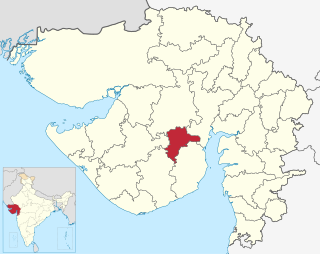
On 25 July 2022, at least 42 people died and more than 97 were hospitalized in a methanol poisoning incident in Gujarat, India. The victims had consumed undiluted methyl alcohol (methanol), assuming it to be alcohol. The spurious liquor was then sold to more than 100 people in the villages of Ahmedabad, Botad and Surendranagar.

The Consequences of Prohibition did not just include effects on people's drinking habits but also on the worldwide economy, the people's trust of the government, and the public health system. Alcohol, from the rise of the temperance movement to modern day restrictions around the world, has long been a source of turmoil. When alcoholic beverages were first banned under the Volstead Act in 1919, the United States government had little idea of the severity of the consequences. It was first thought that a ban on alcohol would increase the moral character of society, but a ban on alcohol had vast unintended consequences.
